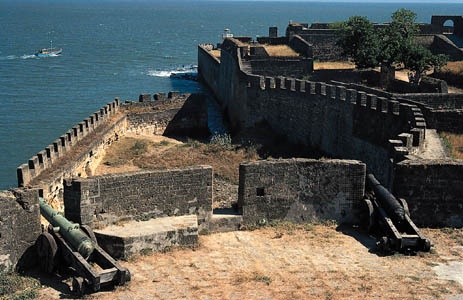Damān and Diu
union territory, India
Introduction
union territory of India, comprising two widely separated districts on the country's western coast. Damān, with an area of 28 square miles (72 square km), is an enclave on the state of Gujarāt's southern coast, situated 100 miles (160 km) north of Bombay (Mumbai). Diu, an island 15 square miles (40 square km) in area, lies off the southern coast of Gujarāt's Kāthiāwār Peninsula (Kathiawar Peninsula), 40 miles southeast of Verāval. Pop. (2001 prelim.) 158,059.
Physical and human geography
 Damān lies on an alluvial coastal plain, although outcrops of basalt create low plateaus and headlands in the area. The Damānganga River flows through the territory, with Damān town situated where the river enters the Arabian Sea. Mean daily maximum temperatures range from 84 °F (29 °C) in January to 93 °F (34 °C) in May. Annual rainfall, received mainly between June and September, averages 81 inches (2,057 mm). Diu, whose territory includes a small area of the mainland, is separated from the Kāthiāwār Peninsula by a narrow swampy creek. Much of the island is covered by sand, silt, and marsh. Temperatures are similar to those of Damān, though rainfall is significantly less (23 inches 【584 mm】 annually).
Damān lies on an alluvial coastal plain, although outcrops of basalt create low plateaus and headlands in the area. The Damānganga River flows through the territory, with Damān town situated where the river enters the Arabian Sea. Mean daily maximum temperatures range from 84 °F (29 °C) in January to 93 °F (34 °C) in May. Annual rainfall, received mainly between June and September, averages 81 inches (2,057 mm). Diu, whose territory includes a small area of the mainland, is separated from the Kāthiāwār Peninsula by a narrow swampy creek. Much of the island is covered by sand, silt, and marsh. Temperatures are similar to those of Damān, though rainfall is significantly less (23 inches 【584 mm】 annually).The people of Damān and Diu are predominantly Hindu, with small Muslim and Christian minorities. Gujarātī is the main language in both districts. One-fifth of Damān's population is tribal. Agriculture and fishing dominate the economies of Damān and Diu. Rice, ragi (also called finger millet), pulses (legumes), and beans are the main crops of Damān; in Diu, however, where only 20 percent of the land area is cultivated, crops such as bajra (pearl millet) and wheat are more suited to the arid climate. Industrial development remains relatively limited. Damān and Diu, the only towns in their respective districts, are the main commercial and service centres.
Damān and Diu, each organized as an administrative district, together constitute a centrally governed union territory headed by an administrator (the governor of Goa) appointed by the central Indian government.
History
The name Damān probably is derived from the Damānganga River, while Diu is from the Sanskrit word dvīpa, meaning “island.” Since Mauryan times (3rd century BC), both have been subject to various local and regional powers ruling in western India. In the 13th century, Damān formed part of the Rāmnagar state, which then became a tributary of the Gujarāt sultans. Similarly, numerous dynasties in Kāthiāwār (Saurāshṭra) ruled Diu until it fell to the sultan of Gujarāt in the early 15th century.
The Portuguese acquired both Damān and Diu as part of their grand design to control the trade of the Indian Ocean. In 1535, under treaty with Bahādur Shāh of Gujarāt, the Portuguese built a fort at Diu, an important port on the flourishing commercial and pilgrimage routes between India and the Middle East. By the mid-1550s, all Gujarātī ships entering and leaving the Gulf of Khambhāt (Cambay) ports were required to call at Diu to pay Portuguese duties. Renowned for its docks and shipbuilding yards, Damān (known in Portuguese as Damão) was conquered by the Portuguese in 1559. Both areas were subject to the governor-general of Goa as part of the Portuguese overseas province Estado da India (State of India). They remained under Portuguese rule for more than four centuries, though the decline of the Portuguese empire in Asia greatly diminished their strategic significance. Damān and Diu survived as outposts of Portuguese overseas territory until 1961, when they were occupied by India.
Additional Reading
Works dealing specifically with the west and west-central area prior to its annexation by India are mainly in Portuguese; see Henry Scholberg, Archana Ashok Kakodker, and Carmo Azevedo, Bibliography of Goa and the Portuguese in India (1982). See also M.N. Pearson, Merchants and Rulers in Gujarat: The Response to the Portuguese in the Sixteenth Century (1976); and K.S. Mathew, Portuguese and the Sultanate of Gujarat, 1500–1573 (1986). The territory of Damān and Diu as well as that of Goa are described in V.T. Gune (ed.), Gazetteer of the Union Territory Goa, Daman and Diu, 3 vol. in 2 (1979). S.S. Desai, Goa, Daman and Diu, Dadra and Nagar Haveli (1976), is a study of the three union territories.
- Brechin
- Brecht, Arnold
- Brecht, Bertolt
- Breckenridge
- Breckinridge, John
- Breckinridge, John C
- Breckinridge, Madeline McDowell
- Breckinridge, Mary
- Breckinridge, Sophonisba Preston
- Breckland
- Brecknockshire
- Brecon
- Brecon Beacons National Park
- Breda
- Breda, Treaty of
- Brederode, Hendrik van
- Bredero, Gerbrand Adriaenszoon
- breed association
- breeder reactor
- breeze
- Bregendahl, Marie
- Bregenz
- Bregenzerwald
- Breguet, Abraham-Louis
- Brehon laws